Unit10 Why was it built 第二课时 Reading
- 格式:ppt
- 大小:1.72 MB
- 文档页数:11
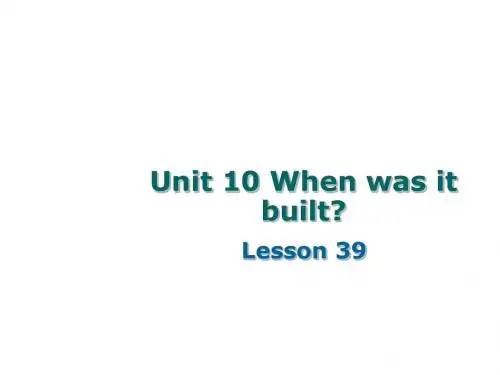


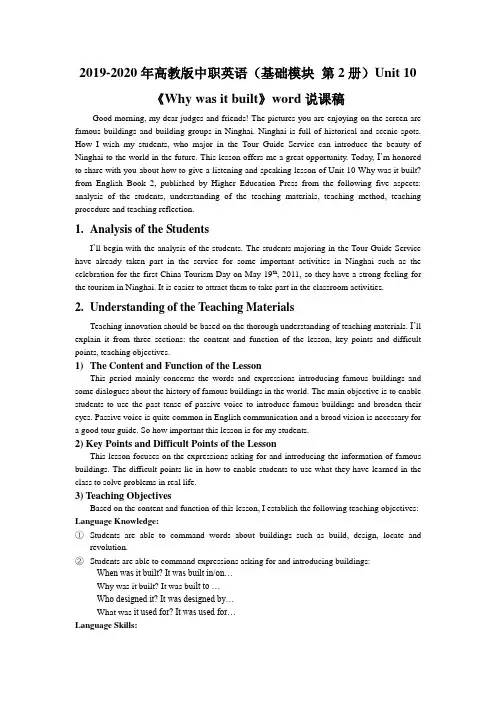
2019-2020年高教版中职英语(基础模块第2册)Unit 10《Why was it built》word说课稿Good morning, my dear judges and friends! The pictures you are enjoying on the screen are famous buildings and building groups in Ninghai. Ninghai is full of historical and scenic spots. How I wish my students, who major in the Tour Guide Service can introduce the beauty of Ninghai to the world in the future. This lesson offers me a great opportunity. Today, I’m honored to share with you about how to give a listening and speaking lesson of Unit 10 Why was it built? from English Book 2, published by Higher Education Press from the following five aspects: analysis of the students, understanding of the teaching materials, teaching method, teaching procedure and teaching reflection.1.Analysis of the StudentsI’ll begin with the analysis of the students. The students majoring in the Tour Guide Service have already taken part in the service for some important activities in Ninghai such as the celebration for the first China Tourism Day on May 19th, 2011, so they have a strong feeling for the tourism in Ninghai. It is easier to attract them to take part in the classroom activities.2.Understanding of the Teaching MaterialsTeaching innovation should be based on the thorough understanding of teaching materials. I’ll explain it from three sections: the content and function of the lesson, key points and difficult points, teaching objectives.1)The Content and Function of the LessonThis period mainly concerns the words and expressions introducing famous buildings and some dialogues about the history of famous buildings in the world. The main objective is to enable students to use the past tense of passive voice to introduce famous buildings and broaden their eyes. Passive voice is quite common in English communication and a broad vision is necessary fora good tour guide. So how important this lesson is for my students.2) Key Points and Difficult Points of the LessonThis lesson focuses on the expressions asking for and introducing the information of famous buildings. The difficult points lie in how to enable students to use what they have learned in the class to solve problems in real life.3) Teaching ObjectivesBased on the content and function of this lesson, I establish the following teaching objectives: Language Knowledge:①Students are able to command words about buildings such as build, design, locate andrevolution.②Students are able to command expressions asking for and introducing buildings:When was it built? It was built in/on…Why was it built? It was bui lt to …Who designed it? It was designed by…What was it used for? It was used for…Language Skills:①Students are able to predict before listening and listen for detailed information by catching thekey words to understand the dialogues talking about the famous buildings②Students are able to talk about the famous buildings with each other by using the key wordsand expressionsCultural Awareness: Students are able to get familiar with the history of some famous western buildings.Affection:①Students are able to broaden their eyes by getting familiar with some famous buildings in theworld and love their own hometown by introducing its famous buildings.②Students are able to cooperate with others by selectively putting the materials together tomake an introduction of one famous building.3.Teaching MethodsTo achieve the above teaching objectives, situational teaching method and task-based language teaching method are adopted in this class.4.Teaching ProceduresT eaching procedures are the most important of a successful teaching. Before class, apart from making a multi-media courseware and Question-Answer cards which will be used in the speaking activity, I’ll divide the students into groups of 6 according to their language ability. As for the students, they need to collect materials about famous buildings in Ninghai (such as pictures, videos, the location and so on). With everything prepared, here come the six teaching steps:Step 1: Lead-inI will play the video showing famous buildings in Ninghai one minute before class to help students begin their English learning in a relaxing atmosphere.With the help of the video, I smoothly begin the class by talking about the tourism in Ninghai to activate students’ background knowledge and preset a task for the students: it is your honorable duty to introduce the famous buildings in Ninghai to the world. And all the following activities are to help them prepare for this duty.First of all, broaden their eyes. A matching competition will be held between groups and details about the buildings will be introduced later by showing more pictures and asking them the following questions: Where is it? Why was it built? to lead in the study of key expressions. Group cooperation can relieve students’ fear caused by the unfamiliarity with the English expressions of these famous buildings while group competition can fully motivate their learning enthusiasm.Step 2: ListeningThe students may know a lot about one famous building, but how to introduce it to tourists? I will introduce the magical blanket of Aladdin to link different teaching steps and change the whole boring listening process into a wonderful traveling to enjoy famous buildings in the world and experience how to guide a tourist to visit famous buildings at the same time. This is the point where I integrate the teaching materials and set an interesting situation for students.Students are certainly eager to begin their traveling, but which buildings are we going to visit? They will listen to three tour guides introducing the three buildings and order the pictures. This step serves as preparation for the following activities by briefly introducing the background knowledge of three buildings, which follows the study law-from the easy to the difficult.Then we will arrive in the first stop of our wonderful travel-the Statue of Liberty. I’ll ask the students: If you are the tour guide, what questions do you think the tourists will ask? Do you know the answers? With their own predictions in mind, a flash will be followed to check the answers by circling the questions they hear and completing the fact file. In the above process, students are not passively asked to do some meaningless listening activities. Instead, they actively explore for the information through different listening strategies directed by different questions and experience the use of key expressions. The information technology makes it possible to let students play an initiative role in a vivid learning environment.Step 3: SpeakingThe Statue of Liberty is a gift from the French people, so in the following step, I’ll lead students to France to visit the Eiffel Tower. Students need to win the passports for themselves by helping the magical blanket finish the Question-Answer cards. They will read aloud after the tape, underline the questions about the information of buildings to put into the Question card of a tourist and then find the answers to put into the Information card of a tour guide. The listening activities act as a role of implicit learning, and then this activity is to cultivate students’ ability to summarize and help students command the key expressions in an explicit way.After receiving enough input, now it’s time for the students to output. I will lead them to visit the Eiffel Tower by showing a flash to let students understand how to use Question-Answer cards to act out a dialogue. After that, we will be in the last stop of our wonderful travel. It’s students’turn to guide me to visit the Great Wall. A video showing its beautiful scenery will be played and students need to act out a dialogue by using the provided Question-Answer Cards. By role playing, students become the masters of the class while the teacher is a helper who offers the information cards. They are given the opportunity to speak out and practice the key expressions again.Step 4: TaskEnsuring that the students have enough language foundation after a series of listening and speaking activities, the preset task at the beginning of the class is presented to them. They need to work in groups and finish the following tasks:First, share the materials they have collected with their group members and choose a famous building they all like.Then discuss with each other about the building and put together the materials to make an introduction of it.(Possible questions to think about: What was the building used for? When was it built? Who designed? Why was it built? Why is it famous? Is there any interesting stories about it...)At last, each group should choose a representative to show the result to the whole class and then the whole class chooses the best tour guide according to the following standards:The standards not only act as guidance for the students to work out the group task during the discussion, but also attract the attention of the whole class during the show time.The highlight of this step is creating a language situation closely related with their major by making full use of local characteristics. And this is what I do to break through the difficult points of this lesson.Step Five Self-checkThe following step is self-check. It presents the key contents of this lesson to deepen students ’ impression and also helps the teacher to check whether the targeted teaching objectives are reached or not. What ’s more, it offers two different levels for students to choose from, which can meet the different needs of students in different language levels.Step Six HomeworkAfter class, students need to work in groups again and choose a famous building in Activity1. Collect as much information about it as possible by searching the Internet. Make full use of what they have learned in the class to make an oral presentation in the next class.5. Teaching ReflectionAs teachers, we should always help students study more efficiently and get ready for their future study or future jobs. In this class, all the teaching activities are carefully designed to meet students ’ real needs and help students develop their overall language ability by playing an initiative role in a situation close to the real life and future career. And the information technology shows its great advantage in breaking through the key and difficult points of this lesson. It provides sounds, pictures and visual images such as flashes and videos to make it possible to let students intuitively experience the language used in scenes which they are unfamiliar with such as visiting the Statue of Liberty and Eiffel Tower.6. LayoutAt last, I’d like to show the layout as follows:Self-check Sheet。
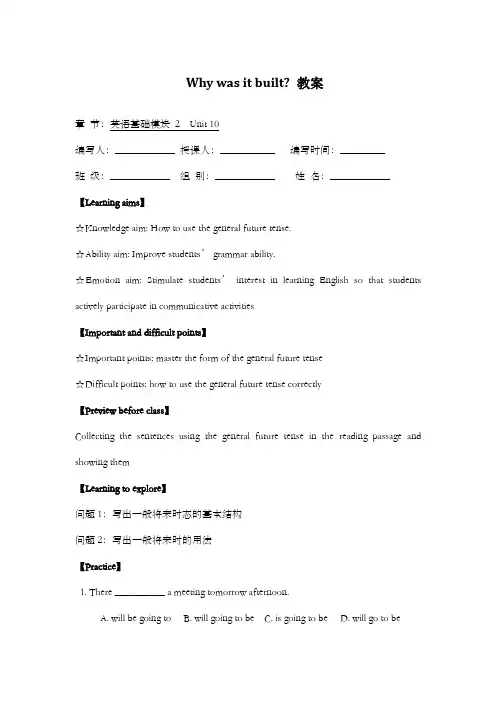
Why was it built? 教案章节:英语基础模块2 Unit 10编写人:____________ 授课人:___________ 编写时间:_________班级:____________ 组别:____________ 姓名:____________ 【Learning aims】☆Knowledge aim: How to use the general future tense.☆Ability aim: Improve students’ grammar ability.☆Emotion aim: Stimulate students’ interest in learning English so that students actively participate in communicative activities【Important and difficult points】☆Important points: master the form of the general future tense☆Difficult points: how to use the general future tense correctly【Preview before class】Collecting the sentences using the general future tense in the reading passage and showing them【Learning to explore】问题1:写出一般将来时态的基本结构问题2:写出一般将来时的用法【Practice】1. There __________ a meeting tomorrow afternoon.A. will be going toB. will going to beC. is going to beD. will go to be2. Charlie ________ here next month.A. isn’t workingB. doesn’t workingC. isn’t going to workingD. won’t work3. He ________ very busy this week, he ________ free next week.A. will be; isB. is; isC. will be; will beD. is; will be4. There ________ a dolphin show in the zoo tomorrow evening.A. wasB. is going to haveC. will haveD. is going to be5. –________ you ________ free tomorrow?– No. I ________ free the day after tomorrow.A. Are; going to; willB. Are; going to be; willC. Are; going to; will beD. Are; going to be; will be6. Mother ________ me a nice present on my next birthday.A. will givesB. will giveC. givesD. give7. – Shall I buy a cup of tea for you?–________. (不,不要。
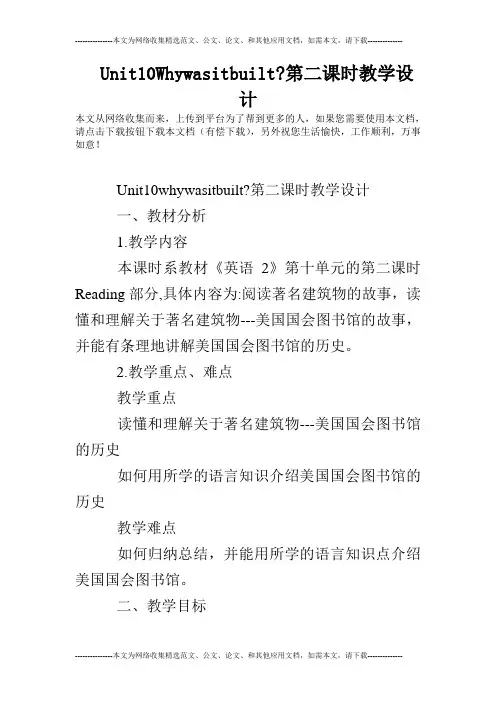
Unit10Whywasitbuilt?第二课时教学设计本文从网络收集而来,上传到平台为了帮到更多的人,如果您需要使用本文档,请点击下载按钮下载本文档(有偿下载),另外祝您生活愉快,工作顺利,万事如意!Unit10whywasitbuilt?第二课时教学设计一、教材分析1.教学内容本课时系教材《英语2》第十单元的第二课时Reading部分,具体内容为:阅读著名建筑物的故事,读懂和理解关于著名建筑物---美国国会图书馆的故事,并能有条理地讲解美国国会图书馆的历史。
2.教学重点、难点教学重点读懂和理解关于著名建筑物---美国国会图书馆的历史如何用所学的语言知识介绍美国国会图书馆的历史教学难点如何归纳总结,并能用所学的语言知识点介绍美国国会图书馆。
二、教学目标1.知识目标掌握关于美国国会图书馆的词汇,如:thelargestlibrary;location;collectionofbooks;librarycards; namechanging;include;capitolBuilding;rebuild;moveinto; benamesfor;president;theLibraryofcongressetcUnderstandtheinformationofthepassageGraspthemainideasandfilltheimportantinformationofthep assage.2.能力目标学生学习阅读策略,训练如何从文中获取细节信息并整理归纳信息的能力。
3.情感目标学习中外的著名的建筑物,丰富和开拓视野,增强学习英语的乐趣。
三、教学步骤SteponeLead-in二、Askquestions:Showsomepicturesoflibraryincludingschoollibraryandloc allibrary,thenaskquestion:??Showapictureofthelongestprivatelibraryinchina:(注解:天一阁是中国现存年代最早的私家藏书楼,也是亚洲现有最古老的图书馆和世界最早的三大家族图书馆之一。

Why was it built? 英语教案一、教学目标:1. 让学生能够理解并运用目标句型"Why was it built?" 询问建筑物的建造原因。
2. 让学生通过图片和情景对话,提高观察力和口语表达能力。
3. 培养学生的团队协作能力和问题解决能力。
二、教学内容:1. 词汇:castle, palace, temple, bridge, tower, rport, hospital, school, factory, museum, library2. 句型:Why was it built? It was built for三、教学重点与难点:1. 重点:词汇的学习和运用,句型的练习。
2. 难点:询问建筑物建造原因的语境理解和运用。
四、教学方法:1. 情境教学法:通过展示图片和情景对话,让学生在实际情境中学习和运用目标句型。
2. 任务型教学法:通过小组合作完成任务,培养学生的问题解决能力和团队协作能力。
五、教学步骤:1. 导入:展示一座城堡的图片,引导学生思考城堡的建造原因,引出本课的主题。
2. 新课内容:教授词汇和句型,让学生通过模仿和练习掌握目标句型"Why wasit built?" 的用法。
3. 情景对话:设计一组情景对话,让学生在实际情境中运用目标句型,理解建筑物建造原因的询问方式。
4. 小组任务:将学生分成小组,每组选择一座建筑物,通过观察和讨论,找出建筑物的建造原因,并用目标句型进行表达。
5. 展示和评价:各小组展示自己的成果,其他学生和教师对其进行评价,给予肯定和建议。
6. 总结和作业布置:总结本课所学内容,布置作业,要求学生运用目标句型询问和表达建筑物的建造原因。
教案编写仅供参考,具体实施可根据实际情况进行调整。
六、教学延伸:1. 小组活动:让学生分组,每组选择一个城市,调查该城市的建筑物建造原因,并用英语进行报告。
2. 角色扮演:学生分组,每组选择一个历史时期,扮演那时的建筑师或统治者,用英语讨论建造建筑物的理由。
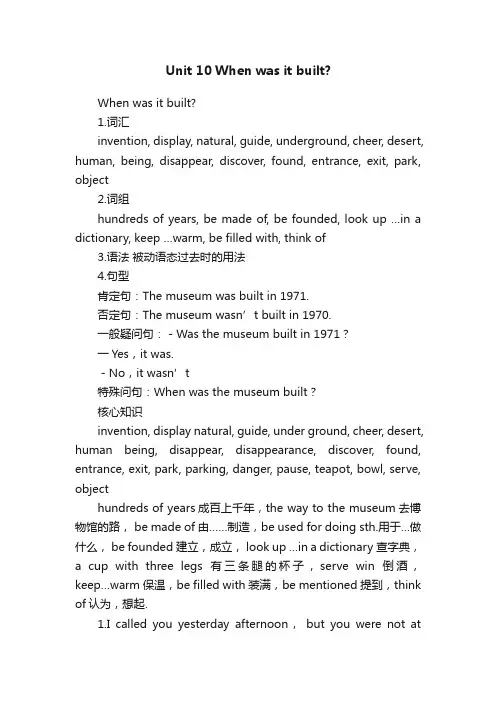
Unit 10 When was it built?When was it built?1.词汇invention, display, natural, guide, underground, cheer, desert, human, being, disappear, discover, found, entrance, exit, park, object2.词组hundreds of years, be made of, be founded, look up …in a dictionary, keep …warm, be filled with, think of3.语法被动语态过去时的用法4.句型肯定句:The museum was built in 1971.否定句:The museum wasn’t built in 1970.一般疑问句:-Was the museum built in 1971?一Yes,it was.-No,it wasn’t特殊问句:When was the museum built?核心知识invention, display natural, guide, under ground, cheer, desert, human being, disappear, disappearance, discover, found, entrance, exit, park, parking, danger, pause, teapot, bowl, serve, objecthundreds of years成百上千年,the way to the museum去博物馆的路, be made of由……制造,be used for doing sth.用于…做什么, be founded建立,成立,look up …in a dictionary查字典,a cup with three legs有三条腿的杯子,serve win倒酒,keep…warm保温,be filled with装满,be mentioned提到,think of认为,想起.1.I called you yesterday afternoon,but you were not athome.我昨天下午给你打个电话,可是你不在家.call sb.给某人打电话,相当于give sb. a call 或fling up sb.I will ask her to give you a call tomorrow.我明天要他给你打电话.Mary rang up her father last night.昨晚玛丽给父亲打过电话.2. …I went to the biggest museum in town yesterday.昨天我到城里最大的博物馆去了.in town在镇里(城里)介词短语在这里作定语,修饰前面名词“the biggest museum.”3. The biggest museum?最大的博物馆?这句话是一个省略问句,其完全形式是“Did you go to the biggest science museum?”4.I saw many old inventions on show.我看到许多古老的发明在展览.invention 名词,其动词为invent“发明”.同词根为“inventor”,“发明家”.如:Edison was a great inventor. He invented many useful things all his life。
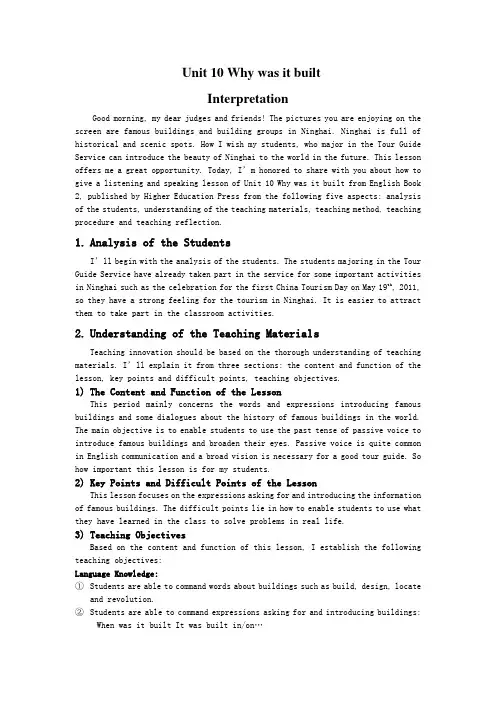
Unit 10 Why was it builtInterpretationGood morning, my dear judges and friends! The pictures you are enjoying on the screen are famous buildings and building groups in Ninghai. Ninghai is full of historical and scenic spots. How I wish my students, who major in the Tour Guide Service can introduce the beauty of Ninghai to the world in the future. This lesson offers me a great opportunity. Today, I’m honored to share with you about how to give a listening and speaking lesson of Unit 10 Why was it built from English Book 2, published by Higher Education Press from the following five aspects: analysis of the students, understanding of the teaching materials, teaching method, teaching procedure and teaching reflection.1.Analysis of the StudentsI’ll begin with the analysis of the students. The students majoring in the Tour Guide Service have already taken part in the service for some important activities in Ninghai such as the celebration for the first China Tourism Day on May 19th, 2011, so they have a strong feeling for the tourism in Ninghai. It is easier to attract them to take part in the classroom activities.2.Understanding of the Teaching MaterialsTeaching innovation should be based on the thorough understanding of teaching materials. I’ll explain it from three sections: the content and function of the lesson, key points and difficult points, teaching objectives.1)The Content and Function of the LessonThis period mainly concerns the words and expressions introducing famous buildings and some dialogues about the history of famous buildings in the world. The main objective is to enable students to use the past tense of passive voice to introduce famous buildings and broaden their eyes. Passive voice is quite common in English communication and a broad vision is necessary for a good tour guide. So how important this lesson is for my students.2) Key Points and Difficult Points of the LessonThis lesson focuses on the expressions asking for and introducing the information of famous buildings. The difficult points lie in how to enable students to use what they have learned in the class to solve problems in real life.3) Teaching ObjectivesBased on the content and function of this lesson, I establish the following teaching objectives:Language Knowledge:①Students are able to command words about buildings such as build, design, locateand revolution.②Students are able to command expressions asking for and introducing buildings:When was it built It was built in/on…Why was it built It was built to …Who designed it It was designed by…What was it used for It was used for…Language Skills:①Students are able to predict before listening and listen for detailed informationby catching the key words to understand the dialogues talking about the famous buildings②Students are able to talk about the famous buildings with each other by usingthe key words and expressionsCultural Awareness: Students are able to get familiar with the history of some famous western buildings.Affection:①Students are able to broaden their eyes by getting familiar with some famousbuildings in the world and love their own hometown by introducing its famous buildings.②Students are able to cooperate with others by selectively putting the materialstogether to make an introduction of one famous building.3.Teaching MethodsTo achieve the above teaching objectives, situational teaching method and task-based language teaching method are adopted in this class.4.Teaching ProceduresT eaching procedures are the most important of a successful teaching. Before class, apart from making a multi-media courseware and Question-Answer cards which will be used in the speaking activity, I’ll divide the students into groups of 6 according to their language ability. As for the students, they need to collect materials about famous buildings in Ninghai (such as pictures, videos, the location and so on). With everything prepared, here come the six teaching steps:Step 1: Lead-inI will play the video showing famous buildings in Ninghai one minute before class to help students begin their English learning in a relaxing atmosphere.With the help of the video, I smoothly begin the class by talking about the tourism in Ninghai to activate students’background knowledge and preset a task for the students: it is your honorable duty to introduce the famous buildings in Ninghai to the world. And all the following activities are to help them prepare for this duty.First of all, broaden their eyes. A matching competition will be held between groups and details about the buildings will be introduced later by showing more pictures and asking them the following questions: Where is it Why was it built to lead in the study of key expressions. Group cooperation can relieve students’fear caused by the unfamiliarity with the English expressions of these famous buildings while group competition can fully motivate their learning enthusiasm.Step 2: ListeningThe students may know a lot about one famous building, but how to introduce itto tourists I will introduce the magical blanket of Aladdin to link different teaching steps and change the whole boring listening process into a wonderful traveling to enjoy famous buildings in the world and experience how to guide a tourist to visit famous buildings at the same time. This is the point where I integrate the teaching materials and set an interesting situation for students.Students are certainly eager to begin their traveling, but which buildings are we going to visit They will listen to three tour guides introducing the three buildings and order the pictures. This step serves as preparation for the following activities by briefly introducing the background knowledge of three buildings, which follows the study law-from the easy to the difficult.Then we will arrive in the first stop of our wonderful travel-the Statue of Liberty. I’ll ask the students: If you are the tour guide, what questions do you think the tourists will ask Do you know the answers With their own predictions in mind, a flash will be followed to check the answers by circling the questions they hear and completing the fact file. In the above process, students are not passively asked to do some meaningless listening activities. Instead, they actively explore for the information through different listening strategies directed by different questions and experience the use of key expressions. The information technology makes it possible to let students play an initiative role in a vivid learning environment.Step 3: SpeakingThe Statue of Liberty is a gift from the French people, so in the following step, I’ll lead students to France to visit the Eiffel Tower. Students need to win the passports for themselves by helping the magical blanket finish the Question-Answer cards. They will read aloud after the tape, underline the questions about the information of buildings to put into the Question card of a tourist and then find the answers to put into the Information card of a tour guide. The listening activities act as a role of implicit learning, and then this activity is to cultivate students’ability to summarize and help students command the key expressions in an explicit way.After receiving enough input, now it’s time for the students to output. I will lead them to visit the Eiffel Tower by showing a flash to let students understand how to use Question-Answer cards to act out a dialogue. After that, we will be in the last stop of our wonderful travel. It’s students’ turn to guide me to visit the Great Wall. A video showing its beautiful scenery will be played and students need to act out a dialogue by using the provided Question-Answer Cards. By role playing, students become the masters of the class while the teacher is a helper who offers the information cards. They are given the opportunity to speak out and practice the key expressions again.Step 4: TaskEnsuring that the students have enough language foundation after a series of listening and speaking activities, the preset task at the beginning of the class is presented to them. They need to work in groups and finish the following tasks:First, share the materials they have collected with their group members and choose a famous building they all like.Then discuss with each other about the building and put together the materials to make an introduction of it.(Possible questions to think about: What was the building used for When was it built Who designed Why was it built Why is it famous Is there any interesting stories about it...)At last, each group should choose a representative to show the result to the whole class and then the whole class chooses the best tour guide according to the following standards:The standards not only act as guidance for the students to work out the group task during the discussion, but also attract the attention of the whole class during the show time.The highlight of this step is creating a language situation closely related with their major by making full use of local characteristics. And this is what I do to break through the difficult points of this lesson.Step Five Self-checkThe following step is self-check. It presents the key contents of this lesson to deepen students’ impression and also helps the teacher to check whether the targeted teaching objectives are reached or not. What’s more, it offers two different levels for students to choose from, which can meet the different needs of students in different language levels.Step Six HomeworkAfter class, students need to work in groups again and choose a famous building in Activity1. Collect as much information about it as possible by searching the Internet. Make full use of what they have learned in the class to make an oral presentation in the next class.5.Teaching ReflectionAs teachers, we should always help students study more efficiently and get readyfor their future study or future jobs. In this class, all the teaching activities are carefully designed to meet students’real needs and help students develop their overall language ability by playing an initiative role in a situation close to the real life and future career. And the information technology shows its great advantage in breaking through the key and difficult points of this lesson. It provides sounds, pictures and visual images such as flashes and videos to make it possible to let students intuitively experience the language used in scenes which they are unfamiliar with such as visiting the Statue of Liberty and Eiffel Tower.youtAt last, I’d like to show the layout as follows:Self-check Sheet。


Unit 10 Why was it built?InterpretationGood morning, my dear judges and friends! The pictures you are enjoying on the screen are famous buildings and building groups in Ninghai. Ninghai is full of historical and scenic spots. How I wish my students, who major in the Tour Guide Service can introduce the beauty of Ninghai to the world in the future. This lesson offers me a great opportunity. Today, I’m honored to share with you about how to give a listening and speaking lesson of Unit 10 Why was it built? from English Book 2, published by Higher Education Press from the following five aspects: analysis of the students, understanding of the teaching materials, teaching method, teaching procedure and teaching reflection.1.Analysis of the StudentsI’ll begin with the analysis of the students. The students majoring in the Tour Guide Service have already taken part in the service for some important activities in Ninghai such as the celebration for the first China Tourism Day on May 19th, 2011, so they have a strong feeling for the tourism in Ninghai. It is easier to attract them to take part in the classroom activities.2.Understanding of the Teaching MaterialsTeaching innovation should be based on the thorough understanding of teaching materials. I’ll explain it from three sections: the content and function of the lesson, key points and difficult points, teaching objectives.1)The Content and Function of the LessonThis period mainly concerns the words and expressions introducing famous buildings and some dialogues about the history of famous buildings in the world. The main objective is to enable students to use the past tense of passive voice to introduce famous buildings and broaden their eyes. Passive voice is quite common in English communication and a broad vision is necessary fora good tour guide. So how important this lesson is for my students.2) Key Points and Difficult Points of the LessonThis lesson focuses on the expressions asking for and introducing the information of famous buildings. The difficult points lie in how to enable students to use what they have learned in the class to solve problems in real life.3) Teaching ObjectivesBased on the content and function of this lesson, I establish the following teaching objectives: Language Knowledge:①Students are able to command words about buildings such as build, design, locate andrevolution.②Students are able to command expressions asking for and introducing buildings:When was it built? It was built in/on…Why was it built? It was built to …Who design ed it? It was designed by…What was it used for? It was used for…Language Skills:①Students are able to predict before listening and listen for detailed information by catching thekey words to understand the dialogues talking about the famous buildings②Students are able to talk about the famous buildings with each other by using the key wordsand expressionsCultural Awareness: Students are able to get familiar with the history of some famous western buildings.Affection:①Students are able to broaden their eyes by getting familiar with some famous buildings in theworld and love their own hometown by introducing its famous buildings.②Students are able to cooperate with others by selectively putting the materials together tomake an introduction of one famous building.3.Teaching MethodsTo achieve the above teaching objectives, situational teaching method and task-based language teaching method are adopted in this class.4.Teaching ProceduresT eaching procedures are the most important of a successful teaching. Before class, apart from making a multi-media courseware and Question-Answer cards which will be used in the speaking activity, I’ll divide the students into groups of 6 according to their language ability. As for the students, they need to collect materials about famous buildings in Ninghai (such as pictures, videos, the location and so on). With everything prepared, here come the six teaching steps:Step 1: Lead-inI will play the video showing famous buildings in Ninghai one minute before class to help students begin their English learning in a relaxing atmosphere.With the help of the video, I smoothly begin the class by talking about the tourism in Ninghai to activate students’ background knowledge and preset a task for the students: it is your honorable duty to introduce the famous buildings in Ninghai to the world. And all the following activities are to help them prepare for this duty.First of all, broaden their eyes. A matching competition will be held between groups and details about the buildings will be introduced later by showing more pictures and asking them the following questions: Where is it? Why was it built? to lead in the study of key expressions. Group cooperation can relieve students’ fear caused by the unfamiliarity with the English expressions of these famous buildings while group competition can fully motivate their learning enthusiasm.Step 2: ListeningThe students may know a lot about one famous building, but how to introduce it to tourists? I will introduce the magical blanket of Aladdin to link different teaching steps and change the whole boring listening process into a wonderful traveling to enjoy famous buildings in the world and experience how to guide a tourist to visit famous buildings at the same time. This is the point where I integrate the teaching materials and set an interesting situation for students.Students are certainly eager to begin their traveling, but which buildings are we going to visit? They will listen to three tour guides introducing the three buildings and order the pictures. This step serves as preparation for the following activities by briefly introducing the background knowledge of three buildings, which follows the study law-from the easy to the difficult.Then we will arrive in the first stop of our wonderful travel-the Statue of Liberty. I’ll ask the students: If you are the tour guide, what questions do you think the tourists will ask? Do you know the answers? With their own predictions in mind, a flash will be followed to check the answers by circling the questions they hear and completing the fact file. In the above process, students are not passively asked to do some meaningless listening activities. Instead, they actively explore for the information through different listening strategies directed by different questions and experience the use of key expressions. The information technology makes it possible to let students play an initiative role in a vivid learning environment.Step 3: SpeakingThe Statue of Liberty is a gift from the French people, so in the following step, I’ll lead students to France to visit the Eiffel Tower. Students need to win the passports for themselves by helping the magical blanket finish the Question-Answer cards. They will read aloud after the tape, underline the questions about the information of buildings to put into the Question card of a tourist and then find the answers to put into the Information card of a tour guide. The listening activities act as a role of implicit learning, and then this activity is to cultivate students’ ability to summarize and help students command the key expressions in an explicit way.After receiving enough input, now it’s time for the students to output. I will lead them to visit the Eiffel Tower by showing a flash to let students understand how to use Question-Answer cards to act out a dialogue. After that, we will be in the last stop of our wonderful travel. It’s students’turn to guide me to visit the Great Wall. A video showing its beautiful scenery will be played and students need to act out a dialogue by using the provided Question-Answer Cards. By role playing, students become the masters of the class while the teacher is a helper who offers the information cards. They are given the opportunity to speak out and practice the key expressions again.Step 4: TaskEnsuring that the students have enough language foundation after a series of listening and speaking activities, the preset task at the beginning of the class is presented to them. They need to work in groups and finish the following tasks:First, share the materials they have collected with their group members and choose a famous building they all like.Then discuss with each other about the building and put together the materials to make an introduction of it.(Possible questions to think about: What was the building used for? When was it built? Who designed? Why was it built? Why is it famous? Is there any interesting stories about it...)At last, each group should choose a representative to show the result to the whole class and then the whole class chooses the best tour guide according to the following standards:The standards not only act as guidance for the students to work out the group task during the discussion, but also attract the attention of the whole class during the show time.The highlight of this step is creating a language situation closely related with their major by making full use of local characteristics. And this is what I do to break through the difficult points of this lesson.Step Five Self-checkThe following step is self-check. It presents the key contents of this lesson to deepen students ’ impression and also helps the teacher to check whether the targeted teaching objectives are reached or not. What’s more, it offers two different levels for students to choose from, which can meet the different needs of students in different language levels.Step Six HomeworkAfter class, students need to work in groups again and choose a famous building in Activity1. Collect as much information about it as possible by searching the Internet. Make full use of what they have learned in the class to make an oral presentation in the next class.5. Teaching ReflectionAs teachers, we should always help students study more efficiently and get ready for their future study or future jobs. In this class, all the teaching activities are carefully designed to meet students ’ real needs and help students develop their overall language ability by playing an initiative role in a situation close to the real life and future career. And the information technology shows its great advantage in breaking through the key and difficult points of this lesson. It provides sounds, pictures and visual images such as flashes and videos to make it possible to let students intuitively experience the language used in scenes which they are unfamiliar with such as visiting the Statue of Liberty and Eiffel Tower.6. LayoutAt last, I’d like to show the layout as follows:Self-check Sheet。
Unit10 Why was it built?(第一课时教学设计)【课题】Unit10 Why was it built?【课时】第1课时(45分钟)【设计理念】本教案以学生为主体,以任务型教学为中心而设计,通过多媒体网络课件的图像、声音、动画、文字等多种信息功能激发学生的学习兴趣和内在学习动力,设置层层递进的学习任务,在做中学,在做中练,在做中巩固,使学生掌握基本的语句表达,设置真实情境,让学生能以导游的身份简单介绍著名建筑。
在运用英语完成任务的过程中不仅学习英语语言知识,更培养了学生用英语获取信息、处理信息及分析与解决的能力。
【学情简析】本单元的话题是国内外著名建筑物, 有助于开阔学生眼界,激发学生兴趣。
是本课时的教学重点是要求学生能够听懂建筑物的建造时间、所在位置及其他简单信息;能够读懂著名建筑物的简单对话;理解并学会运用有关建筑物和景点表达所需的词汇和句型;能正确运用一般过去时的被动语态简单介绍建筑物的历史。
本单元的设计对象是国贸专业学生,该班总体学习气氛较好,大多数学生对英语感兴趣,希望学好英语,但口语表达能力不强,大部分同学不敢开口说英文。
针对此现象,考虑通过教师铺垫、同伴互助、小组合作学习的方式引导更多学生自主学习,使更多学生愿意参与教学活动,尽力完成各项语言任务。
【教材解析】1.教学内容本课时系教材《英语2》(基础模块高教版)第十单元的第一课时,包括Lead-in & Listening and speaking两部分,具体内容为:了解有关著名的建筑物,听懂关于著名建筑物的建造时间、所在位置及其他简单信息。
掌握有关表达建筑物的建造时间、所在位置等简单信息的词汇、句型。
2. 教学目标(1)语言知识目标了解世界著名建筑物的专有名词,如the Golden Gate Bridge,the Palace Museum,Stonehenge,Sydney Opera House,the Pisa Tower,the Taj Mahal,Statue of Liberty, Eiffel Tower etc。
Why was it built? 英语教案一、教学目标:1. 让学生掌握询问建筑物建造原因的句型"Why was it built?"2. 让学生能够用英语简单描述建筑物的历史和背景。
3. 提高学生对英语听说能力的培养。
二、教学内容:1. 导入:通过展示一些著名的建筑物图片,引导学生思考为什么这些建筑物会被建造。
2. 新课内容:教授句型"Why was it built?",并通过举例子的方式让学生理解如何使用这个句型。
3. 练习:通过小组讨论的方式,让学生练习使用"Why was it built?" 句型,描述不同的建筑物。
三、教学方法:1. 采用任务型教学法,通过小组合作完成任务。
2. 使用多媒体教学,展示建筑物图片,增加学生兴趣。
3. 引导学生通过思考和讨论,主动参与学习过程。
四、教学评价:1. 通过小组讨论的表现来评价学生的听说能力。
2. 通过课后作业,让学生用"Why was it built?" 句型写一篇小短文,来评价学生的写作能力。
五、课后作业:要求学生选择一座建筑物,用"Why was it built?" 句型写一篇小短文,描述这座建筑物建造的原因和历史背景。
六、教学资源:1. 建筑物图片和相关信息。
2. 教学PPT。
3. 录音机或音响设备。
七、教学步骤:1. 导入:展示建筑物图片,引导学生思考为什么这些建筑物会被建造。
2. 新课内容:教授句型"Why was it built?",并通过举例子的方式让学生理解如何使用这个句型。
3. 练习:通过小组讨论的方式,让学生练习使用"Why was it built?" 句型,描述不同的建筑物。
4. 听力练习:播放一段关于建筑物建造原因的录音,让学生回答相关问题。
5. 总结:回顾本节课所学的句型和内容,强调其重要性。